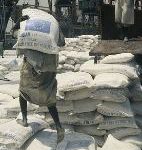The world stood on the brink of starvation and, warned doomsday forecasts in the 1960s, the battle to feed all of humanity was already lost. Famine was common in some of the most populated countries. Predictions of Malthusian catastrophe made the bestseller lists, with Paul R Ehrlich writing in The Population Bomb that by the 1970s and 1980s the victims would number in the hundreds of millions.
But human ingenuity saved the day. A massive programme of investment in agricultural research and infrastructure – avidly supported by the United States out of a cold-war-fuelled fear that hungry countries could fall into the arms of the Soviet Union – led to an explosion in farm productivity. Nations that never dreamt of being able to feed themselves were transformed into net exporters of food.
Those efforts, led by Norman Borlaug, an American agronomist who was later awarded the Nobel peace prize, resulted in the development of higher-yielding seeds and an exceptional expansion in the use of irrigation, fertilisers and pesticides in developing countries.
By 1968 the jump in farm productivity was so clear – India, for example, harvested a record wheat crop, as did the Philippines for rice – that William Gaud, administrator of the US Agency for International Development (USAID), said the world was witnessing the “makings of a new revolution”.
“It is not a violent red revolution like that of the Soviets, nor is it a white revolution like that of the Shah of Iran,” Gaud said in a speech 40 years ago. “I call it the green revolution,” he added, coining a term that has long survived him.
Yet, like its counterparts elsewhere on the spectrum, the “green revolution” eventually lost momentum. Today, the world stands on the brink again as agricultural commodity prices surge, triggering food riots in countries from Haiti to Bangladesh. This time, however, efforts to increase supply – and the political backing in Washington and other capitals – appear far weaker. The task of raising productivity, meanwhile, is rendered more difficult by record oil prices, which make fertiliser more expensive.
In dozens of interviews with agriculture officials and experts, a consensus emerges: even if the current food crisis is the result of multiple factors, such as biofuel demand or extreme weather, its roots are in the waning green revolution. “The foundation of the current crisis is the slowdown in farm productivity,” says Lennart Båge, president of the United Nations’ International Fund for Agricultural Development (IFAD) in Rome.
The green revolution was in many respects a victim of its own success. The increase in food production from the early 1960s was so great that it not only staved off global hunger but also opened the way to almost 40 years of cheap and abundant food supplies. Wheat yields per hectare, for example, jumped from less than 500 kilogrammes to nearly 3,000 kilogrammes today. Indeed, for most of the 1990s the problem was too much food, with much talk in Europe of grain “mountains” and “lakes” of milk and wine.
Akinwumi Adesina, vice president of the Alliance for a Green Revolution in Africa (AGRA), says this cornucopia of inexpensive food generated a profound sense of complacency. “People started thinking that support into agriculture research was no longer necessary to boost productivity further, as there was already more than enough food and prices were falling.”
As a result, investment in agricultural research and infrastructure declined sharply. Multilateral organisations such as the World Bank and individual rich donor countries cut the share of agricultural spending in their development assistance to less than 3% in 2004, down from a peak of 18% in 1979, according to the Paris-based Organisation for Economic Co-operation and Development (OECD). In money terms, even adjusted for inflation, farm aid was more than halved — to about US$3 billion in 2004 from US$8 billion in 1979.
Although private-sector funding for agricultural research grew, low food prices on world markets meant this work generally focused on innovations that reduced costs rather than enhanced yields. It was always publicly funded research that was more likely to concentrate on innovations that would increase yields and production, particularly in parts of the world where farmers are unable to pay royalties for new varieties of seeds, says Ronald Trostle of the US Department of Agriculture’s Economic Research Service.
Less investment translated into slowing productivity growth. According to the USDA, crop yields increased at an annual rate of 1.1% on average from 1990 to 2007, compared with the 2% rate achieved in 1970 to 1990. The impact on yield growth in important staples such as wheat and rice was even more acute, slowing to about 1% per year from annual rates of as high as 10% in the early 1960s.
The decline in productivity growth could scarcely have come at a worse time. Food demand has been rising in this decade as the world’s population expands and a swelling middle class in countries such as China consumes more protein, such as meat and milk. The development of the biofuels industry further increased demand, accounting this year for one-third of the United States corn crop.
Now, for the first time since the 1970s, the world is slowly depleting its food stocks, each year consuming more than it produces. Also as a result of climate upsets including droughts, inventories are at record lows and prices are rocketing. “It was an accident waiting to happen,” Adesina says.
Policymakers are waking up to the urgency of the situation. Manmohan Singh, India’s prime minister, recently declared that “there is persistent feeling that the first green revolution has run its course”. He went on to say that the world needs a second such transformation if it is to resolve the food crisis: “The global community and global agencies must fashion a collective response that leads to a quantum leap in agricultural productivity and output, so that the spectre of food shortages is banished from the horizon once again.”
That was high on the agenda of the United Nations’ Food and Agriculture Organisation (FAO) summit, held in Rome in early June 2008, attended by some 40 heads of state and government. Jacques Diouf, head of the FAO, says this a rare moment: “For the first time in 25 years, a fundamental incentive – high food commodity prices – is in place for stimulating the agricultural sector. Governments, supported by their international partners, must now undertake the necessary public investment and provide a favourable environment for private investments.” Or as Ed Schafer, the US agriculture secretary, recently put it: “If countries do not increase yields…people are going to go hungry. It’s that simple.”
Yet replicating the first green revolution will be difficult. Each of the three pillars on which it was built – seed technology, irrigation and the ample use of fertilisers and pesticides – now look rather less sturdy. Again, that largely reflects the legacy of how the problem was tackled the first time round.
As millions of lives were at risk from hunger and results were needed fast, scientists and policymakers focused on increasing production at whatever cost. Tom Mew, who worked as the principal scientist at the International Rice Research Institute (IRRI) at Los Baños in the Philippines in the 1960s, acknowledged that bias a few years ago: “It was a tough choice, so we focused on high-input agriculture that would ensure that everyone got fed.”
The result is a global agricultural system that today is highly intensive and is predicated on the availability of cheap, readily available energy, for use in every part of the production chain: both directly as fuel and indirectly to manufacture fertilisers and pesticides. But with oil prices rising, the cost of certain fertilisers has surged to more than US$1,000 a tonne from about US$300 a tonne two years ago. On top of that, the use of chemical fertilisers and pesticides faces public opposition.
The original green revolution also required vast amounts of water for irrigation – a resource that is becoming scarcer because of climate change and the rapid growth of cities and industrial operations, particularly in the developing world.
Last, the 1960s improvements in seed technology achieved higher yields as well as an improved resistance to drought and insects. Scientists are approaching the limits of what they can do through natural techniques. The next step – the use of genetically modified (GM) organisms – faces strong opposition, particularly in Europe but also, for instance, in some African countries.
In short, the easy gains already have been made, except in Africa. Shivaji Pandey, who was involved in the first green revolution and now heads the plant production division at the FAO in Rome, says the world now needs a “smarter” green revolution. “We will need to increase farm production with less water and a more efficient use of fertilisers,” he says. Alexander Evans, a fellow at New York University’s Center on International Co-operation (CIC), says the key is making the green revolution “greener”. He argues: “It needs to be much more input-efficient.”
To do that, experts argue, water management should move from the relatively cheap flood irrigation widely used in south-east Asia to much more expensive sprinkler and drip systems. Those would require investments that developing countries could afford only with donor support, officials say. “Water will be a limiting factor,” says Adesina.
Fertilisers pose a bigger challenge. The FAO thinks it is possible to economise on their use, particularly in some south-east Asian countries, through programmes that educate farmers on how much they need to drop on their fields and when. But in the long term, experts say, fertiliser use will increase, particularly in Africa, meaning that donor countries probably would need to subsidise chemicals for poor countries.
Some experts, such as Tom Lumpkin, director of the International Wheat and Maize Improvement Center (CIMMYT) in El Batán, Mexico, add that countries will need to reconsider their opposition to genetically modified organisms in the light of the crisis. “We need science to come back to farming,” Lumpkin says.
Already 100 million hectares, or about 8% of the world’s cultivated land, are sown with genetically modified organisms. The technology’s supporters, such as the United States and Brazil, are likely to press their point ever more firmly that embracing GM crops could help resolve the problem. Gaddi Vasquez, the US representative to the FAO in Rome, says that to increase crop yields, “one of the most promising ways is through GM”.
The World Bank said this year that agriculture was poised for another technological revolution, this time using the tools of biotechnology. “But there is considerable uncertainty about whether this revolution will become a reality for food production in the developing world because of low public investment in these technologies and controversies over their possible risks,” it warned.
On top of the problems with seeds, fertilisers and irrigation, the political climate today is less conducive to massive cash transfers from the rich to the developing world. No one now fears a communist takeover; the investment required would have to come as a simple attempt to improve the lives of millions.
Whatever the course that policymakers chart, officials and experts agree that the world needs to move fast to ease the crisis – and to prevent another in a few years. The OECD and FAO said in May, in their joint Agricultural Outlook 2008-2017, that public and private investments in innovation and increasing farm productivity “would greatly improve supply prospects by helping to broaden the production base and lessen the chance of recurring commodity price spikes”.
But time is something else in short supply. Robert Zeigler, director of the IRRI, says it would take up to a decade to develop the seed varieties and build the infrastructure required for a second green revolution. “In reality, we should have started 10 years ago to avoid today’s problems,” he says.
Next: Africa and agricultural revolution
© Copyright The Financial Times Ltd 2008
Homepage photo by birdfarm


